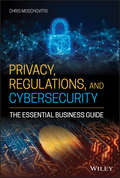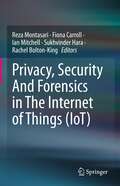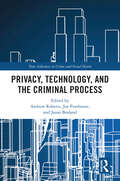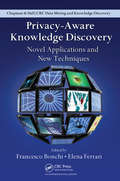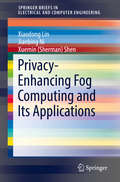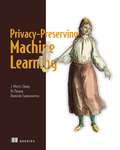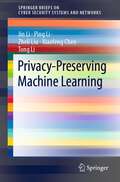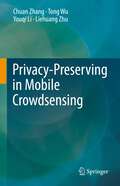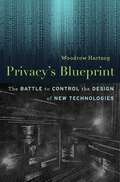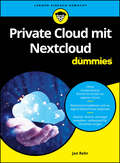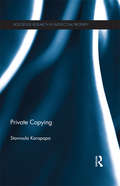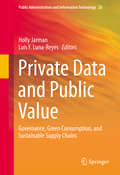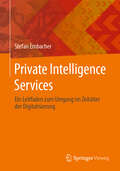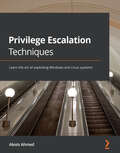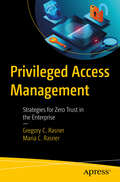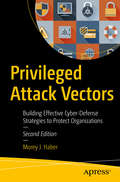- Table View
- List View
Privacy, Regulations, and Cybersecurity: The Essential Business Guide
by Chris MoschovitisProtect business value, stay compliant with global regulations, and meet stakeholder demands with this privacy how-to Privacy, Regulations, and Cybersecurity: The Essential Business Guide is your guide to understanding what “privacy” really means in a corporate environment: how privacy is different from cybersecurity, why privacy is essential for your business, and how to build privacy protections into your overall cybersecurity plan. First, author Chris Moschovitis walks you through our evolving definitions of privacy, from the ancient world all the way to the General Law on Data Protection (GDPR). He then explains—in friendly, accessible language—how to orient your preexisting cybersecurity program toward privacy, and how to make sure your systems are compliant with current regulations. This book—a sequel to Moschovitis’ well-received Cybersecurity Program Development for Business—explains which regulations apply in which regions, how they relate to the end goal of privacy, and how to build privacy into both new and existing cybersecurity programs. Keeping up with swiftly changing technology and business landscapes is no easy task. Moschovitis provides down-to-earth, actionable advice on how to avoid dangerous privacy leaks and protect your valuable data assets. Learn how to design your cybersecurity program with privacy in mind Apply lessons from the GDPR and other landmark laws Remain compliant and even get ahead of the curve, as privacy grows from a buzzword to a business must Learn how to protect what’s of value to your company and your stakeholders, regardless of business size or industry Understand privacy regulations from a business standpoint, including which regulations apply and what they require Think through what privacy protections will mean in the post-COVID environment Whether you’re new to cybersecurity or already have the fundamentals, this book will help you design and build a privacy-centric, regulation-compliant cybersecurity program.
Privacy, Security And Forensics in The Internet of Things (IoT)
by Ian Mitchell Reza Montasari Fiona Carroll Sukhvinder Hara Rachel Bolton-KingThis book provides the most recent security, privacy, technical and legal challenges in the IoT environments. This book offers a wide range of theoretical and technical solutions to address these challenges. Topics covered in this book include; IoT, privacy, ethics and security, the use of machine learning algorithms in classifying malicious websites, investigation of cases involving cryptocurrency, the challenges police and law enforcement face in policing cyberspace, the use of the IoT in modern terrorism and violent extremism, the challenges of the IoT in view of industrial control systems, and the impact of social media platforms on radicalisation to terrorism and violent extremism.This book also focuses on the ethical design of the IoT and the large volumes of data being collected and processed in an attempt to understand individuals’ perceptions of data and trust. A particular emphasis is placed on data ownership and perceived rights online. It examines cyber security challenges associated with the IoT, by making use of Industrial Control Systems, using an example with practical real-time considerations. Furthermore, this book compares and analyses different machine learning techniques, i.e., Gaussian Process Classification, Decision Tree Classification, and Support Vector Classification, based on their ability to learn and detect the attributes of malicious web applications. The data is subjected to multiple steps of pre-processing including; data formatting, missing value replacement, scaling and principal component analysis. This book has a multidisciplinary approach. Researchers working within security, privacy, technical and legal challenges in the IoT environments and advanced-level students majoring in computer science will find this book useful as a reference. Professionals working within this related field will also want to purchase this book.
Privacy, Technology, and the Criminal Process (New Advances in Crime and Social Harm)
by Andrew Roberts, Joe Purshouse, and Jason BoslandThis collection considers the implications for privacy of the utilisation of new technologies in the criminal process. In most modern liberal democratic states, privacy is considered a basic right. Many national constitutions, and almost all international human rights instruments, include some guarantee of privacy. Yet privacy interests appear to have had relatively little influence on criminal justice policy making. The threat that technology poses to these interests demands critical re-evaluation of current law, policy, and practice. This is provided by the contributions to this volume. They offer legal, criminological, philosophical and comparative perspectives. The book will be of interest to legal and criminological scholars and postgraduate students. Its interdisciplinary methodology and focus on the intersection between law and technology make it also relevant for philosophers, and those interested in science and technology studies.
Privacy-Aware Knowledge Discovery: Novel Applications and New Techniques (Chapman & Hall/CRC Data Mining and Knowledge Discovery Series)
by Francesco Bonchi Elena FerrariCovering research at the frontier of this field, Privacy-Aware Knowledge Discovery: Novel Applications and New Techniques presents state-of-the-art privacy-preserving data mining techniques for application domains, such as medicine and social networks, that face the increasing heterogeneity and complexity of new forms of data. Renowned authorities
Privacy-Aware Monitoring for Assisted Living: Ethical, Legal, and Technological Aspects of Audio- and Video-Based AAL Solutions (Intelligent Systems Reference Library #270)
by Albert Ali Salah Liane Colonna Francisco Florez-RevueltaThis open access book provides an interdisciplinary collection of perspectives on the design of privacy-aware audio and video-based monitoring solutions for Active and Assisted Living (AAL). AAL involves leveraging innovative technologies to create supportive and inclusive environments, empowering older, impaired, or frail individuals to live independently and actively participate in society. Bridging technology, law, and ethics, this book explores state-of-the-art approaches for the development of AAL that prioritize user privacy, making it an essential resource for researchers, practitioners, and policymakers in the field. It is the culmination of GoodBrother, a Europe-wide project funded by the COST Association, aimed at enhancing awareness and expertise on the ethical, legal, and privacy issues associated with audio- and video-based monitoring in assisted living contexts. Written by experts from computing, engineering, healthcare, design, law, ethics, and sociology, it provides diverse perspectives into AAL. • Introduces a taxonomy of AAL technologies and applications, providing guidance from data acquisition and processing to interaction and infrastructure of AAL systems. • Describes the core competencies, including machine learning, privacy preservation in audio and video, data security, and security by design. • Presents in-depth reviews and case studies on AAL applications, such as fall detection, gait and frailty recognition, activities of daily living, vital sign monitoring, affective computing, and smart mirrors. • Contains the state of the art and advances in AAL, especially with regards to privacy, ethical, and legal issues, including GDPR, but also the implications of the AI Act and the Cybersecurity Act.
Privacy-Enhancing Fog Computing and Its Applications (SpringerBriefs in Electrical and Computer Engineering)
by Xiaodong Lin Xuemin Sherman Shen Jianbing NiThis SpringerBrief covers the security and privacy challenges in fog computing, and proposes a new secure and privacy-preserving mechanisms to resolve these challenges for securing fog-assisted IoT applications. Chapter 1 introduces the architecture of fog-assisted IoT applications and the security and privacy challenges in fog computing. Chapter 2 reviews several promising privacy-enhancing techniques and illustrates examples on how to leverage these techniques to enhance the privacy of users in fog computing. Specifically, the authors divide the existing privacy-enhancing techniques into three categories: identity-hidden techniques, location privacy protection and data privacy enhancing techniques. The research is of great importance since security and privacy problems faced by fog computing impede the healthy development of its enabled IoT applications. With the advanced privacy-enhancing techniques, the authors propose three secure and privacy-preserving protocols for fog computing applications, including smart parking navigation, mobile crowdsensing and smart grid. Chapter 3 introduces identity privacy leakage in smart parking navigation systems, and proposes a privacy-preserving smart parking navigation system to prevent identity privacy exposure and support efficient parking guidance retrieval through road-side units (fogs) with high retrieving probability and security guarantees. Chapter 4 presents the location privacy leakage, during task allocation in mobile crowdsensing, and propose a strong privacy-preserving task allocation scheme that enables location-based task allocation and reputation-based report selection without exposing knowledge about the location and reputation for participators in mobile crowdsensing. Chapter 5 introduces the data privacy leakage in smart grid, and proposes an efficient and privacy-preserving smart metering protocol to allow collectors (fogs) to achieve real-time measurement collection with privacy-enhanced data aggregation. Finally, conclusions and future research directions are given in Chapter 6. This brief validates the significant feature extension and efficiency improvement of IoT devices without sacrificing the security and privacy of users against dishonest fog nodes. It also provides valuable insights on the security and privacy protection for fog-enabled IoT applications. Researchers and professionals who carry out research on security and privacy in wireless communication will want to purchase this SpringerBrief. Also, advanced level students, whose main research area is mobile network security will also be interested in this SpringerBrief.
Privacy-Preserving Deep Learning: A Comprehensive Survey (SpringerBriefs on Cyber Security Systems and Networks)
by Kwangjo Kim Harry Chandra TanuwidjajaThis book discusses the state-of-the-art in privacy-preserving deep learning (PPDL), especially as a tool for machine learning as a service (MLaaS), which serves as an enabling technology by combining classical privacy-preserving and cryptographic protocols with deep learning. Google and Microsoft announced a major investment in PPDL in early 2019. This was followed by Google’s infamous announcement of “Private Join and Compute,” an open source PPDL tools based on secure multi-party computation (secure MPC) and homomorphic encryption (HE) in June of that year. One of the challenging issues concerning PPDL is selecting its practical applicability despite the gap between the theory and practice. In order to solve this problem, it has recently been proposed that in addition to classical privacy-preserving methods (HE, secure MPC, differential privacy, secure enclaves), new federated or split learning for PPDL should also be applied. This concept involves building a cloud framework that enables collaborative learning while keeping training data on client devices. This successfully preserves privacy and while allowing the framework to be implemented in the real world. This book provides fundamental insights into privacy-preserving and deep learning, offering a comprehensive overview of the state-of-the-art in PPDL methods. It discusses practical issues, and leveraging federated or split-learning-based PPDL. Covering the fundamental theory of PPDL, the pros and cons of current PPDL methods, and addressing the gap between theory and practice in the most recent approaches, it is a valuable reference resource for a general audience, undergraduate and graduate students, as well as practitioners interested learning about PPDL from the scratch, and researchers wanting to explore PPDL for their applications.
Privacy-Preserving Machine Learning
by J. Morris Chang Di Zhuang G. Dumindu SamaraweeraKeep sensitive user data safe and secure without sacrificing the performance and accuracy of your machine learning models.In Privacy Preserving Machine Learning, you will learn: Privacy considerations in machine learning Differential privacy techniques for machine learning Privacy-preserving synthetic data generation Privacy-enhancing technologies for data mining and database applications Compressive privacy for machine learning Privacy-Preserving Machine Learning is a comprehensive guide to avoiding data breaches in your machine learning projects. You&’ll get to grips with modern privacy-enhancing techniques such as differential privacy, compressive privacy, and synthetic data generation. Based on years of DARPA-funded cybersecurity research, ML engineers of all skill levels will benefit from incorporating these privacy-preserving practices into their model development. By the time you&’re done reading, you&’ll be able to create machine learning systems that preserve user privacy without sacrificing data quality and model performance. About the Technology Machine learning applications need massive amounts of data. It&’s up to you to keep the sensitive information in those data sets private and secure. Privacy preservation happens at every point in the ML process, from data collection and ingestion to model development and deployment. This practical book teaches you the skills you&’ll need to secure your data pipelines end to end. About the Book Privacy-Preserving Machine Learning explores privacy preservation techniques through real-world use cases in facial recognition, cloud data storage, and more. You&’ll learn about practical implementations you can deploy now, future privacy challenges, and how to adapt existing technologies to your needs. Your new skills build towards a complete security data platform project you&’ll develop in the final chapter. What&’s Inside Differential and compressive privacy techniques Privacy for frequency or mean estimation, naive Bayes classifier, and deep learning Privacy-preserving synthetic data generation Enhanced privacy for data mining and database applications About the Reader For machine learning engineers and developers. Examples in Python and Java. About the Author J. Morris Chang is a professor at the University of South Florida. His research projects have been funded by DARPA and the DoD. Di Zhuang is a security engineer at Snap Inc. Dumindu Samaraweera is an assistant research professor at the University of South Florida. The technical editor for this book, Wilko Henecka, is a senior software engineer at Ambiata where he builds privacy-preserving software. Table of Contents PART 1 - BASICS OF PRIVACY-PRESERVING MACHINE LEARNING WITH DIFFERENTIAL PRIVACY 1 Privacy considerations in machine learning 2 Differential privacy for machine learning 3 Advanced concepts of differential privacy for machine learning PART 2 - LOCAL DIFFERENTIAL PRIVACY AND SYNTHETIC DATA GENERATION 4 Local differential privacy for machine learning 5 Advanced LDP mechanisms for machine learning 6 Privacy-preserving synthetic data generation PART 3 - BUILDING PRIVACY-ASSURED MACHINE LEARNING APPLICATIONS 7 Privacy-preserving data mining techniques 8 Privacy-preserving data management and operations 9 Compressive privacy for machine learning 10 Putting it all together: Designing a privacy-enhanced platform (DataHub)
Privacy-Preserving Machine Learning (SpringerBriefs on Cyber Security Systems and Networks)
by Jin Li Ping Li Zheli Liu Xiaofeng Chen Tong LiThis book provides a thorough overview of the evolution of privacy-preserving machine learning schemes over the last ten years, after discussing the importance of privacy-preserving techniques. In response to the diversity of Internet services, data services based on machine learning are now available for various applications, including risk assessment and image recognition. In light of open access to datasets and not fully trusted environments, machine learning-based applications face enormous security and privacy risks. In turn, it presents studies conducted to address privacy issues and a series of proposed solutions for ensuring privacy protection in machine learning tasks involving multiple parties. In closing, the book reviews state-of-the-art privacy-preserving techniques and examines the security threats they face.
Privacy-Preserving Techniques with e-Healthcare Applications (Wireless Networks)
by Dengguo Feng Dan Zhu Xuemin (Sherman) ShenThis book investigates novel accurate and efficient privacy-preserving techniques and their applications in e-Healthcare services. The authors first provide an overview and a general architecture of e-Healthcare and delve into discussions on various applications within the e-Healthcare domain. Simultaneously, they analyze the privacy challenges in e-Healthcare services. Then, in Chapter 2, the authors give a comprehensive review of privacy-preserving and machine learning techniques applied in their proposed solutions. Specifically, Chapter 3 presents an efficient and privacy-preserving similar patient query scheme over high-dimensional and non-aligned genomic data; Chapter 4 and Chapter 5 respectively propose an accurate and privacy-preserving similar image retrieval scheme and medical pre-diagnosis scheme over dimension-related medical images and single-label medical records; Chapter 6 presents an efficient and privacy-preserving multi-disease simultaneous diagnosis scheme over medical records with multiple labels. Finally, the authors conclude the monograph and discuss future research directions of privacy-preserving e-Healthcare services in Chapter 7.
Privacy-Preserving in Edge Computing (Wireless Networks)
by Longxiang Gao Tom H. Luan Yong Xiang Bruce Gu Youyang QuWith the rapid development of big data, it is necessary to transfer the massive data generated by end devices to the cloud under the traditional cloud computing model. However, the delays caused by massive data transmission no longer meet the requirements of various real-time mobile services. Therefore, the emergence of edge computing has been recently developed as a new computing paradigm that can collect and process data at the edge of the network, which brings significant convenience to solving problems such as delay, bandwidth, and off-loading in the traditional cloud computing paradigm. By extending the functions of the cloud to the edge of the network, edge computing provides effective data access control, computation, processing and storage for end devices. Furthermore, edge computing optimizes the seamless connection from the cloud to devices, which is considered the foundation for realizing the interconnection of everything. However, due to the open features of edge computing, such as content awareness, real-time computing and parallel processing, the existing problems of privacy in the edge computing environment have become more prominent. The access to multiple categories and large numbers of devices in edge computing also creates new privacy issues. In this book, we discuss on the research background and current research process of privacy protection in edge computing. In the first chapter, the state-of-the-art research of edge computing are reviewed. The second chapter discusses the data privacy issue and attack models in edge computing. Three categories of privacy preserving schemes will be further introduced in the following chapters. Chapter three introduces the context-aware privacy preserving scheme. Chapter four further introduces a location-aware differential privacy preserving scheme. Chapter five presents a new blockchain based decentralized privacy preserving in edge computing. Chapter six summarize this monograph and propose future research directions. In summary, this book introduces the following techniques in edge computing: 1) describe an MDP-based privacy-preserving model to solve context-aware data privacy in the hierarchical edge computing paradigm; 2) describe a SDN based clustering methods to solve the location-aware privacy problems in edge computing; 3) describe a novel blockchain based decentralized privacy-preserving scheme in edge computing. These techniques enable the rapid development of privacy-preserving in edge computing.
Privacy-Preserving in Mobile Crowdsensing
by Liehuang Zhu Tong Wu Chuan Zhang Youqi LiMobile crowdsensing is a new sensing paradigm that utilizes the intelligence of a crowd of individuals to collect data for mobile purposes by using their portable devices, such as smartphones and wearable devices. Commonly, individuals are incentivized to collect data to fulfill a crowdsensing task released by a data requester. This “sensing as a service” elaborates our knowledge of the physical world by opening up a new door of data collection and analysis. However, with the expansion of mobile crowdsensing, privacy issues urgently need to be solved. In this book, we discuss the research background and current research process of privacy protection in mobile crowdsensing. In the first chapter, the background, system model, and threat model of mobile crowdsensing are introduced. The second chapter discusses the current techniques to protect user privacy in mobile crowdsensing. Chapter three introduces the privacy-preserving content-based task allocation scheme. Chapter four further introduces the privacy-preserving location-based task scheme. Chapter five presents the scheme of privacy-preserving truth discovery with truth transparency. Chapter six proposes the scheme of privacy-preserving truth discovery with truth hiding. Chapter seven summarizes this monograph and proposes future research directions. In summary, this book introduces the following techniques in mobile crowdsensing: 1) describe a randomizable matrix-based task-matching method to protect task privacy and enable secure content-based task allocation; 2) describe a multi-clouds randomizable matrix-based task-matching method to protect location privacy and enable secure arbitrary range queries; and 3) describe privacy-preserving truth discovery methods to support efficient and secure truth discovery. These techniques are vital to the rapid development of privacy-preserving in mobile crowdsensing.
Privacy’s Blueprint: The Battle to Control the Design of New Technologies
by Woodrow HartzogEvery day, Internet users interact with technologies designed to undermine their privacy. Social media apps, surveillance technologies, and the Internet of Things are all built in ways that make it hard to guard personal information. And the law says this is okay because it is up to users to protect themselves—even when the odds are deliberately stacked against them. In Privacy’s Blueprint, Woodrow Hartzog pushes back against this state of affairs, arguing that the law should require software and hardware makers to respect privacy in the design of their products. Current legal doctrine treats technology as though it were value-neutral: only the user decides whether it functions for good or ill. But this is not so. As Hartzog explains, popular digital tools are designed to expose people and manipulate users into disclosing personal information. Against the often self-serving optimism of Silicon Valley and the inertia of tech evangelism, Hartzog contends that privacy gains will come from better rules for products, not users. The current model of regulating use fosters exploitation. Privacy’s Blueprint aims to correct this by developing the theoretical underpinnings of a new kind of privacy law responsive to the way people actually perceive and use digital technologies. The law can demand encryption. It can prohibit malicious interfaces that deceive users and leave them vulnerable. It can require safeguards against abuses of biometric surveillance. It can, in short, make the technology itself worthy of our trust.
Private Cloud mit Nextcloud für Dummies (Für Dummies)
by Jan RehrBleiben Sie Herr über Ihre eigenen Daten Wie Sie mit Nextcloud Ihre eigene Cloud betreiben, das erfahren Sie in diesem Buch. Jan Rehr erklärt Ihnen die Grundlagen und klärt die Frage, ob eine vorinstallierte oder eine selbst aufgesetzte Lösung Ihren Bedürfnissen entspricht. Bei Bedarf lernen Sie Schritt für Schritt, Nextcloud auf der besonders lange unterstützten Ubuntu-Version 24.04 LTS zu installieren. Ansonsten legen Sie direkt los, indem Sie Nextcloud an Ihre individuellen Bedürfnisse anpassen, Nutzer anlegen, die Dateiverwaltung und Apps einrichten. Dabei steht die Sicherheit Ihrer Daten stets an erster Stelle! Und los! Sie erfahren Wo Ihnen eine eigene Nextcloud helfen kann Wie Sie Ihre Nextcloud installieren können Was es bei der Administration einer Nextcloud zu beachten gilt Wie Sie den Funktionsumfang Ihrer Nextcloud mit Apps erweitern
Private Copying (Routledge Research in Intellectual Property)
by Stavroula KarapapaThis book offers an original analysis of private copying and determines its actual scope as an area of end-user freedom. The basis of this examination is Article 5(2)(b) of the Copyright Directive. Despite the fact that copying for private and non-commercial use is permitted by virtue of this article and the national laws that implemented it, there is no mandate that this privilege should not be technologically or contractually restricted. Because the legal nature of private copying is not settled, users may consider that they have a ‘right’ to private copying, whereas rightholders are in position to prohibit the exercise of this ‘right’. With digital technology and the internet, this tension has become prominent: the conceptual contours of permissible private copying, namely the private and non-commercial character of the use, do not translate well, and tend to be less clear in the digital context. With the permissible limits of private copying being contested and without clarity as to the legal nature of the private coping limitation, the scope of user freedom is being challenged. Private use, however, has always remained free in copyright law. Not only is it synonymous with user autonomy via the exhaustion doctrine, but it also finds protection under privacy considerations which come into play at the stage of copyright enforcement. The author of this book argues that the rationale for a private copying limitation remains unaltered in the digital world and maintains there is nothing to prevent national judges from interpreting the legal nature of private copying as a ‘sacred’ privilege that can be enforced against possible restrictions. Private Copying will be of particular interest to academics, students and practitioners of intellectual property law.
Private Data and Public Value
by Holly Jarman Luis F. Luna-ReyesThis book investigates the ways inwhich these systems can promote public value by encouraging the disclosure andreuse of privately-held data in ways that support collective values such asenvironmental sustainability. Supported by funding from the National ScienceFoundation, the authors' research team has been working on one such system,designed to enhance consumers ability to access information about thesustainability of the products that they buy and the supply chains that producethem. Pulled by rapidly developing technology and pushed by budget cuts,politicians and public managers are attempting to find ways to increase thepublic value of their actions. Policymakers are increasingly acknowledging thepotential that lies in publicly disclosing more of the data that they hold, aswell as incentivizing individuals and organizations to access, use, and combineit in new ways. Due to technological advances which include smarterphones, better ways to track objects and people as they travel, and moreefficient data processing, it is now possible to build systems which useshared, transparent data in creative ways. The book adds to thecurrent conversation among academics and practitioners about how to promotepublic value through data disclosure, focusing particularly on the roles thatgovernments, businesses and non-profit actors can play in this process, makingit of interest to both scholars and policy-makers.
Private Intelligence Services: Ein Leitfaden zum Umgang im Zeitalter der Digitalisierung
by Stefan EmbacherDie Einführung des Buches legt den Grundstein für die nachfolgenden Kapitel, indem sie die Definitionen und Grundlagen der Wirtschaftskriminalität klärt und ein solides Verständnis für die Dimensionen und die Tragweite dieser Herausforderung schafft. Sie legt dar, wie Wirtschaftskriminalität nicht nur finanzielle Verluste verursacht, sondern auch das Vertrauen in Märkte und Institutionen untergräbt, was weitreichende soziale und wirtschaftliche Konsequenzen nach sich zieht. Im ersten Kapitel wird die Zusammenarbeit zwischen privaten Intelligence-Unternehmen und staatlichen Behörden beleuchtet. Es werden Fallstudien und Beispiele präsentiert, die demonstrieren, wie eine erfolgreiche Partnerschaft aussehen kann, und welche Herausforderungen und Spannungsfelder dabei auftreten können. Das Kapitel unterstreicht die Bedeutung von Vertrauen, Transparenz und gegenseitigem Respekt für den Erfolg dieser Kooperationen. Das zweite Kapitel widmet sich den spezifischen Herausforderungen und Anforderungen, die verschiedene Branchen und Sektoren an private Intelligence-Unternehmen stellen. Es wird detailliert aufgezeigt, wie unterschiedlich die Bedürfnisse von Unternehmen, je nach Größe, Branche und geografischer Lage sein können, und wie maßgeschneiderte Lösungen aussehen können. Es wird deutlich, dass eine tiefgehende Branchenkenntnis und Spezialisierung essentiell sind, um effektive Dienstleistungen zu bieten. Das dritte Kapitel ist in mehrere Unterkapitel gegliedert und deckt ein breites Spektrum an Themen ab, darunter die besonderen Anforderungen bestimmter Zielgruppen, Methoden und Techniken zur Sicherung von Vermögenswerten und Informationen, sowie praxisnahe Fallbeispiele und Best Practices. Hier wird auch aufgezeigt, wie Unternehmen wie Foreus als Dienstleister in der Praxis agieren und welche Rolle sie im Gesamtkontext spielen. Das vierte Kapitel setzt sich mit den rechtlichen und ethischen Aspekten von Private Intelligence auseinander. Es werden aktuelle Gesetzgebungen und Rechtsprechungen diskutiert, ethische Dilemmata beleuchtet und klare Empfehlungen und Richtlinien für verantwortungsvolles Handeln präsentiert. Das fünfte Kapitel blickt in die Zukunft und versucht eine Prognose über die nächsten 10 Jahre im Bereich Private Intelligence und Wirtschaftskriminalität abzugeben. Es werden technologische Entwicklungen, Ausbildungs- und Weiterbildungsmöglichkeiten sowie potentielle Herausforderungen und Chancen diskutiert. Das abschließende sechste Kapitel fasst die zentralen Erkenntnisse zusammen, bietet konkrete Handlungsempfehlungen für verschiedene Fachleute und endet mit abschließenden Gedanken und einem Ausblick in die Zukunft.
Private Investigation and Homeland Security
by Daniel J. BennyThe threat against the homeland continues and the private investigator plays a critical part in this effort. This includes in providing criminal, civil and background investigation, protective service, security consulting and electronic sweeps. The text will provide an overview of the role of private investigation in protection of the homeland and show how such skill can be utilized by business and government in this effort.
Private Security and the Law (5th Edition)
by Charles P. Nemeth<p>Private Security and the Law, Fifth Edition, is a singular resource that provides the most comprehensive analysis of practices in the security industry with respect to law, regulation, licensure, and constitutional questions of case and statutory authority. <p>The book begins with a historical background of the security industry, laws and regulations that walks step-by-step through the analysis of the development of case law over the years as it applies to situations commonly faced by security practitioners. It describes the legal requirements faced by security firms and emphasizes the liability problems common to security operations, including negligence and tortious liability, civil actions frequently litigated, and strategies to avoid legal actions that affect business efficiency. <p>In addition, chapters examine the constitutional and due-process dimensions of private security both domestically and internationally, including recent cases and trends that are likely to intensify in the future. Updated coverage new to this edition includes developments in statutory authority, changes to state and federal processes of oversight and licensure, and special analysis of public-private cooperative relationships in law enforcement.</p>
Private Security: An Introduction to Principles and Practice
by Charles P. NemethThere are few textbooks available that outline the foundation of security principles while reflecting the modern practices of private security as an industry. Private Security: An Introduction to Principles and Practice takes a new approach to the subject of private sector security that will be welcome addition to the field. The book focuses on the recent history of the industry and the growing dynamic between private sector security and public safety and law enforcement. Coverage will include history and security theory, but emphasis is on current practice, reflecting the technology-driven, fast-paced, global security environment. Such topics covered include a history of the security industry, security law, risk management, physical security, Human Resources and personnel, investigations, institutional and industry-specific security, crisis and emergency planning, critical infrastructure protection, IT and computer security, and more. Rather than being reduced to single chapter coverage, homeland security and terrorism concepts are referenced throughout the book, as appropriate. Currently, it vital that private security entities work with public sector authorities seamlessly—at the state and federal levels—to share information and understand emerging risks and threats. This modern era of security requires an ongoing, holistic focus on the impact and implications of global terror incidents; as such, the book’s coverage of topics consciously takes this approach throughout. Highlights include: Details the myriad changes in security principles, and the practice of private security, particularly since 9/11 Focuses on both foundational theory but also examines current best practices—providing sample forms, documents, job descriptions, and functions—that security professionals must understand to perform and succeed Outlines the distinct, but growing, roles of private sector security companies versus the expansion of federal and state law enforcement security responsibilities Includes key terms, learning objectives, end of chapter questions, Web exercises, and numerous references—throughout the book—to enhance student learning Presents the full range of career options available for those looking entering the field of private security Includes nearly 400 full-color figures, illustrations, and photographs. Private Security: An Introduction to Principles and Practice provides the most comprehensive, up-to-date coverage of modern security issues and practices on the market. Professors will appreciate the new, fresh approach, while students get the most "bang for their buck," insofar as the real-world knowledge and tools needed to tackle their career in the ever-growing field of private industry security. An instructor’s manual with Exam questions, lesson plans, and chapter PowerPoint® slides are available upon qualified course adoption.
Private Thoughts
by Lawrence E. DaviesIn 1941 as war with Japan appeared more and more likely, The New York Times opened its first bureau west of the Mississippi in San Francisco. It would be Lawrence E Davies’ office’ for 29 years in what many of his peers considered the best reporting assignment in the world. His beat included northern California, Nevada, Oregon, Washington, Idaho, Montana, Alaska and Hawaii. The report of his death in the New York Times indicated that the files at The Times had over four thousand articles reported with his by- line and additionally, an estimated four thousand unsigned articles. He was held in such high regard, The Times reported, that he was "called by the National Geographic Society a few years ago, a San Francisco landmark along with the Golden Gate Bridge." He had a vast acquaintance among people in all walks of life throughout the West. His private thoughts were kept quiet, even from his family. He typed each thought and placed the typed sheet in a cardboard container. Several years after his death, the container and the fascinating thoughts of the man, so well placed and sensitive to information regarding life in the U.S. during World War II, were discovered by his son Gilbert.
Privately and Publicly Verifiable Computing Techniques
by Denise Demirel Johannes Buchmann Lucas SchabhüserThis book presents the first comprehensive overview of various verifiable computing techniques, which allow the computation of a function on outsourced data to be delegated to a server. It provides a brief description of all the approaches and highlights the properties each solution achieves. Further, it analyzes the level of security provided, how efficient the verification process is, who can act as a verifier and check the correctness of the result, which function class the verifiable computing scheme supports, and whether privacy with respect to t he input and/or output data is provided. On the basis of this analysis the authors then compare the different approaches and outline possible directions for future work. The book is of interest to anyone wanting to understand the state of the art of this research field.
Privilege Escalation Techniques: Learn the art of exploiting Windows and Linux systems
by Alexis AhmedEnumerate and exploit Linux or Windows systems and escalate your privileges to the highest levelKey FeaturesDiscover a range of techniques to escalate privileges on Windows and Linux systemsUnderstand the key differences between Windows and Linux privilege escalationExplore unique exploitation challenges in each chapter provided in the form of pre-built VMsBook DescriptionPrivilege escalation is a crucial step in the exploitation life cycle of a penetration tester. It helps penetration testers to set up persistence and facilitates lateral movement. This book is one of a kind, covering a range of privilege escalation techniques and tools for both Windows and Linux systems. The book uses virtual environments that you can download to test and run tools and techniques. Each chapter will feature an exploitation challenge in the form of pre-built virtual machines (VMs). As you progress, you will learn how to enumerate and exploit a target Linux or Windows system. This privilege escalation book then demonstrates how you can escalate your privileges to the highest level. By the end of this book, you will have gained the skills you need to be able to perform local kernel exploits, escalate privileges through vulnerabilities in services, maintain persistence, and enumerate information from the target such as passwords and password hashes.What you will learnUnderstand the privilege escalation process and set up a pentesting labGain an initial foothold on the systemPerform local enumeration on target systemsExploit kernel vulnerabilities on Windows and Linux systemsPerform privilege escalation through password looting and finding stored credentialsGet to grips with performing impersonation attacksExploit Windows services such as the secondary logon handle service to escalate Windows privilegesEscalate Linux privileges by exploiting scheduled tasks and SUID binariesWho this book is forThis Windows and Linux privilege escalation book is for intermediate-level cybersecurity students and pentesters who are interested in learning how to perform various privilege escalation techniques on Windows and Linux systems, which includes exploiting bugs, design flaws, and more. An intermediate-level understanding of Windows and Linux systems along with fundamental cybersecurity knowledge is expected.
Privileged Access Management: Strategies for Zero Trust in the Enterprise
by Gregory C. Rasner Maria C. RasnerZero trust is a strategy that identifies critical, high-risk resources and greatly reduces the risk of a breach. Zero trust accomplishes this by leveraging key tools, technologies, and governance around Privileged Access Management (PAM). These identities and accounts that have elevated access are the key targets of the bad actors and nearly every event, breach, or incident that occurs is the result of a privileged account being broken into. Many organizations struggle to control these elevated accounts, what tools to pick, how to implement them correctly, and implement proper governance to ensure success in their zero trust strategy. This book defines a strategy for zero trust success that includes a privileged access strategy with key tactical decisions and actions to guarantee victory in the never-ending war against the bad actors.What You Will Learn:The foundations of Zero Trust security and Privileged Access Management.Tie-ins to the ZT strategy and discussions about successful implementation with strategy and governance.How to assess your security landscape including current state, risk-based gaps, tool and technology selection, and assessment output.A step-by-step strategy for Implementation, including planning, execution, governance, and root-cause analysis.Who This Book is for:C-level suite: not designed to be overly technical, but cover material enough to allow this level to be conversant in strategy and leadership needs to success.Director-level in Cyber and IT: this level of personnel are above the individual contributors (IC) and require the information in this book to translate the strategy goals set by C-suite and the tactics required for the ICs to implement and govern.GRC leaders and staff.Individual Contributors: while not designed to be a technical manual for engineering staff, it does provide a Rosetta Stone for themto understand how important strategy and governance are to their success.
Privileged Attack Vectors: Building Effective Cyber-Defense Strategies to Protect Organizations
by Morey J. HaberSee how privileges, insecure passwords, administrative rights, and remote access can be combined as an attack vector to breach any organization. Cyber attacks continue to increase in volume and sophistication. It is not a matter of if, but when, your organization will be breached. Threat actors target the path of least resistance: users and their privileges. In decades past, an entire enterprise might be sufficiently managed through just a handful of credentials. Today’s environmental complexity has seen an explosion of privileged credentials for many different account types such as domain and local administrators, operating systems (Windows, Unix, Linux, macOS, etc.), directory services, databases, applications, cloud instances, networking hardware, Internet of Things (IoT), social media, and so many more. When unmanaged, these privileged credentials pose a significant threat from external hackers and insider threats. We are experiencing an expanding universe of privileged accounts almost everywhere.There is no one solution or strategy to provide the protection you need against all vectors and stages of an attack. And while some new and innovative products will help protect against or detect against a privilege attack, they are not guaranteed to stop 100% of malicious activity. The volume and frequency of privilege-based attacks continues to increase and test the limits of existing security controls and solution implementations. Privileged Attack Vectors details the risks associated with poor privilege management, the techniques that threat actors leverage, and the defensive measures that organizations should adopt to protect against an incident, protect against lateral movement, and improve the ability to detect malicious activity due to the inappropriate usage of privileged credentials. This revised and expanded second edition covers new attack vectors, has updated definitions for privileged access management (PAM), new strategies for defense, tested empirical steps for a successful implementation, and includes new disciplines for least privilege endpoint management and privileged remote access. What You Will LearnKnow how identities, accounts, credentials, passwords, and exploits can be leveraged to escalate privileges during an attack Implement defensive and monitoring strategies to mitigate privilege threats and risk Understand a 10-step universal privilege management implementation plan to guide you through a successful privilege access management journeyDevelop a comprehensive model for documenting risk, compliance, and reporting based on privilege session activity Who This Book Is For Security management professionals, new security professionals, and auditors looking to understand and solve privilege access management problems
